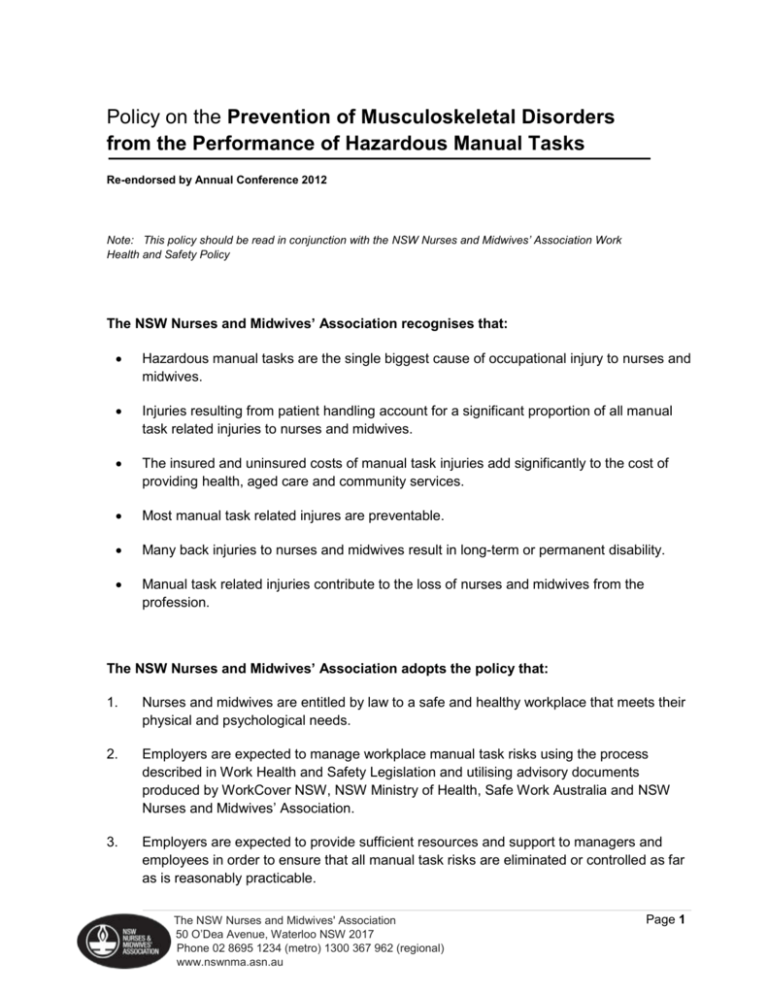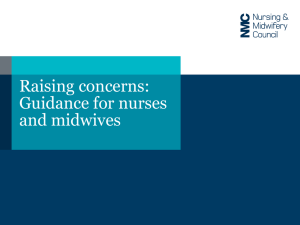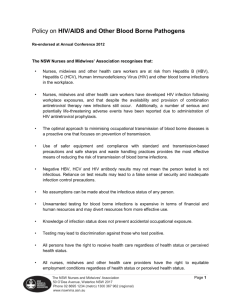NSWNMA Policy on the Prevention of Musculoskeletal Disorders
advertisement

Policy on the Prevention of Musculoskeletal Disorders from the Performance of Hazardous Manual Tasks Re-endorsed by Annual Conference 2012 Note: This policy should be read in conjunction with the NSW Nurses and Midwives’ Association Work Health and Safety Policy The NSW Nurses and Midwives’ Association recognises that: Hazardous manual tasks are the single biggest cause of occupational injury to nurses and midwives. Injuries resulting from patient handling account for a significant proportion of all manual task related injuries to nurses and midwives. The insured and uninsured costs of manual task injuries add significantly to the cost of providing health, aged care and community services. Most manual task related injures are preventable. Many back injuries to nurses and midwives result in long-term or permanent disability. Manual task related injuries contribute to the loss of nurses and midwives from the profession. The NSW Nurses and Midwives’ Association adopts the policy that: 1. Nurses and midwives are entitled by law to a safe and healthy workplace that meets their physical and psychological needs. 2. Employers are expected to manage workplace manual task risks using the process described in Work Health and Safety Legislation and utilising advisory documents produced by WorkCover NSW, NSW Ministry of Health, Safe Work Australia and NSW Nurses and Midwives’ Association. 3. Employers are expected to provide sufficient resources and support to managers and employees in order to ensure that all manual task risks are eliminated or controlled as far as is reasonably practicable. The NSW Nurses and Midwives' Association 50 O’Dea Avenue, Waterloo NSW 2017 Phone 02 8695 1234 (metro) 1300 367 962 (regional) www.nswnma.asn.au Page 1 4. All hazardous manual task related risks must be identified, assessed and controlled in accordance with the legislation, approved codes of practice, other relevant guidance materials and recognised risk management practice. This includes manual task risks associated with all nursing and midwifery activities including direct and indirect patient care activities. 5. Risk identification, assessment and control must be carried out in consultation with the nurses and midwives carrying out the work. 6. The risk identification, assessment and control process is ongoing with the aim being to continuously reduce manual task related risks. This means that the manual task risk management program should be regularly evaluated and reviewed. This includes the regular review and evaluation of work environments, staffing levels and skill mix, systems of work, risk control strategies, fixtures, fittings, furniture, equipment and training. 7. Risk management incorporates the assessment of risks associated with the use of premises, fixtures, fittings and equipment, including manual handling equipment. Once the risks have been assessed, safe procedures, such as safe operating procedures for using equipment, can be developed. 8. While standard approaches to managing risks arising from manual tasks exist, these should be assessed for their appropriateness to each specific situation. 9. The employer should aim to control hazardous manual task related risks at their source and provide the most effective control strategies possible. Note that the Work Health and Safety Regulation requires structures and plant to be designed (as far as is reasonably practicable) so as to eliminate the need for hazardous manual tasks. This means that: 9.1 the employer should take all reasonable steps to provide premises, work environments, furniture (e.g. patient beds), fixtures and fittings, equipment and work practices that eliminate or minimise hazardous manual task related risks, 9.2 systems of work, work practices and procedures should be examined with a view to eliminating hazardous manual tasks where possible, 9.3 where hazardous manual task related risks cannot be eliminated, risks should be reduced through the provision of suitable equipment, premises, furniture, fixtures and fittings, 9.4 in all instances, information on hazardous manual task risks and training in manual handling and the safe use of equipment must be provided and reviewed regularly, and The NSW Nurses and Midwives' Association 50 O’Dea Avenue, Waterloo NSW 2017 Phone 02 8695 1234 (metro) 1300 367 962 (regional) www.nswnma.asn.au Page 2 9.5 10. 11. in all instances, the employer must consult with nurses and midwives when determining risk control strategies including the design/redesign of work premises. In relation to the handling of patients, the NSW Nurses and Midwives’ Association endorses approaches that eliminate manual handling of patients where possible and, where this is not possible, reduce the risk of patient handling through the provision of adequate and well designed work environments, furniture, fittings and fixtures, equipment, systems of work and training. This means that employers should: 10.1 eliminate patient handling where possible by design/redesign of premises, work environments, procedures and work routines, 10.2 provide equipment such as hoists, slide sheets, electric beds and other manual handling aids to reduce the risk of injury (to nurses, midwives and patients) where patient handling cannot be eliminated, 10.3 assess the manual handling needs of patients prior to admission or, if this is not practicable, as soon as possible after admission. Patient assessment should include health status, and physical, functional and cognitive capabilities, and special needs, e.g. bariatric equipment. This applies to the full range of health, aged care and disability services including community based services. The patient’s manual handling needs should be included in the patient care plan, which should be regularly reviewed, 10.4 place patients only into areas where their manual task related needs can be met, 10.5 encourage patients to assist in their own transfers as far as possible – maintaining patient independence is important, 10.6 provide nurses and midwives with competency based training in manual tasks including patient assessment, risk assessment, risk control strategies, and the safe use of equipment, and 10.7 eliminate the manual lifting (including team lifting) of all or most of a patient’s body weight in all but exceptional or life threatening circumstances where no other alternative is available. In relation to manual task equipment, employers should: 11.1 consult with nurses, midwives and experts in the selection of equipment for their use, The NSW Nurses and Midwives' Association 50 O’Dea Avenue, Waterloo NSW 2017 Phone 02 8695 1234 (metro) 1300 367 962 (regional) www.nswnma.asn.au Page 3 11.2 ensure that equipment is well designed with controls that are easy to use and reduce the risk of injuries, 11.3 trial equipment before purchase to ensure that the equipment meets the needs of nurses, midwives and patients and is appropriate for the use for which it is intended, 11.4 purchase equipment options that are fit for purpose and are lowest risk, 11.5 provide nurses and midwives with training in the safe use of equipment, 11.6 maintain equipment in good order and replace it as necessary, 11.7 provide sufficient storage for equipment and accessories close to the point of use, 11.8 provide sufficient quantities of frequently used equipment and associated attachments to ensure equipment is close to hand and available when needed, and 11.9 purchase equipment on the basis of fitness for purpose, design and safety rather than cost. 12. Staffing levels must be adequate and accommodate the manual handling needs of patients, compliance with safe work practices and the safe use of equipment. 13. Facility planning, construction or renovation should always be consistent with manual handling policy and include consultation with nurses and midwives. Appropriately qualified consultants should be commissioned to ensure construction plans meet manual handling guidelines and the Australasian Health Facility Guidelines. 14. The general layout of the workplace should be conducive to the safe handling of patients and the safe use of equipment. There should be sufficient clear space to safely move and transfer patients and equipment. Flooring should allow hoists and trolleys to move easily when loaded. 15. Modifications to the workplace should be carried out where necessary to ensure a safe working environment. 16. Provision of manual handling training is mandatory under legislation. It must be given a high priority with dedicated resources. 17. While essential, training should not be the only manual handling risk control measure used. Employers must endeavour, wherever possible, to eliminate or reduce risks at their source. The NSW Nurses and Midwives' Association 50 O’Dea Avenue, Waterloo NSW 2017 Phone 02 8695 1234 (metro) 1300 367 962 (regional) www.nswnma.asn.au Page 4 18. Manual handling policies should include measures of the effectiveness of manual handling training including the assessment of nurses’ and midwives’ manual handling skills before and after training and at regular intervals. 19. Nurses and midwives must be provided with undergraduate, induction and ongoing training in manual tasks appropriate to their level of responsibility including: 19.1 the principles of manual handling, 19.2 risk factors for injury. 19.3 how to assess patients for their manual handling needs, 19.4 how to select the safest options for carrying out nursing and midwifery activities, 19.5 how to use manual handling equipment, according to safe operating procedures, 19.6 preferred techniques for moving and transferring patients that involve minimal force and exertion, 19.7 techniques for emergency situations, 19.8 the risk management process, and 19.9 how to report hazards and injuries. 20. In addition to the above, supervisors must be trained in how to conduct manual handling risk assessments and investigations. 21. Officers and senior managers must be trained in risk management and how to develop a hazardous manual task risk management programs. 22. Nurses and midwives should cooperate with the employer and comply with preventive policies, programs and procedures as trained and instructed. This includes participation in opportunities for consultation, attendance at training; compliance with safe work practices and the use of equipment, reporting hazards and injuries (including instances where compliance with safe work practices was not possible); and compliance with rehabilitation programs developed for their benefit or the benefit of their colleagues. 22. Nursing and midwifery managers are responsible for developing, implementing and evaluating organisational policies and programs and supporting nurses and midwives in their areas of control. The NSW Nurses and Midwives' Association 50 O’Dea Avenue, Waterloo NSW 2017 Phone 02 8695 1234 (metro) 1300 367 962 (regional) www.nswnma.asn.au Page 5 Notes: A hazardous manual task is defined in the Work Health and Safety Regulation 2011 as a task that requires a person to lift, lower, push, pull, carry, or otherwise hold or restrain any person, animal or thing that involves one or more of the following: (a) Repetitive or sustained force (b) High or sudden forces (c) Repetitive movement (d) Sustained or awkward posture (e) Exposure to vibration The word ‘patient’ as used in this policy is interchangeable with the terms ‘client’ and ‘resident’ as appropriate. References: Work Health and Safety Act 2011 Work Health and Safety Regulation 2011, especially parts 3.1 and 4.2 Hazardous Manual Tasks Code of Practice The NSW Nurses and Midwives' Association 50 O’Dea Avenue, Waterloo NSW 2017 Phone 02 8695 1234 (metro) 1300 367 962 (regional) www.nswnma.asn.au Page 6




